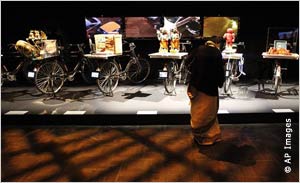
U.S. embassy and consulate websites or www.state.gov.
We’ve gone social!
Follow us on our facebook pages and join the conversation.
10 March 2011
Crafts Inspired by India Dazzle at “maximum INDIA” Exhibition

Washington — From water jugs to jewelry, the Indian works of art, crafts and artifacts on display at the Kennedy Center for the Performing Arts in Washington are decorated in dazzling, intricate ways. No matter what an item’s purpose — to express religious faith, to sell a product or to interpret history — it is likely to be stunningly adorned.
The centerpiece arts exhibition at “maximum INDIA” is a darkened space with rows of street bicycles bookended by large-screen videos of urban life in Mumbai. The 28 bikes have rear racks stacked high with handcrafted objects, practical and whimsical, representing every Indian state and region. This installation and most of the art is on loan to the Washington festival from New Delhi’s Craft Museum, although some of it comes from private collections.
Several of the bikes have small video screens, attached where rear reflectors normally would be, depicting how the objects on display are used in everyday life on India’s urban streets and in its rural areas. A bike with a rack holding a handmade drum-bell musical instrument, for example, has a corresponding video screen of a street performer using an identical drum-bell machine. Another bike supports a screen showing video of a chai wallah, or tea maker, and a rack that holds his actual pots and cups.
One bicycle holds an assemblage of metal food containers, or tiffins, that women typically pack with lunches for their families. In many parts of India, especially Mumbai, daily armies of delivery workers, or tiffin wallahs, fan out across the city by train, bicycle and every other possible kind of conveyance to deliver hot meals to children and workers at schools or job sites.
“This is folk art that is being contemporized in many different ways and will vary considerably from [Indian] state to state,” said Manjula Kumar of the Smithsonian Institution’s Center for Education and Museum Studies.
The artisans seem to use the most inexpensive local materials for their craft objects, she observed, whether clay, bronze, wood or even grass. They also incorporate and reinterpret the cultural influences around them, modern and traditional.
Depending on the region from which an artisan hails, Kumar added, he or she might decorate practical items, such as water jars and food containers, with Persian- or Mughal-influenced designs, bright abstract colors or whimsical images of Hindu gods and goddesses.
“There are so many ways of depicting Ganish,” Kumar said, pointing to the elephant-head god perched on the lid of a pot.
Kumar smiled at a display of elegant measuring bowls for cooking. “As if Indian women ever measured anything,” she said with a laugh.

OPULENCE
The festival displays 40 jewelry pieces on loan from the renowned Gem Palace in Jaipur. The necklaces, rings, bracelets, brooches and earrings are adorned with rose-cut diamonds, emeralds, rubies, enamel, gold, and rare natural pearls — lots and lots of them.
The jewels reflect variations on traditional designs, but all were made in the last 10 years by artisans working for the Kasliwal family, whose ancestors founded the Gem Palace in 1852. Today, the family manages every aspect of production, from mining and cutting the gems to designing settings.
On display is a jaw-dropping wedding set consisting of a necklace, headdress and earrings encrusted with a total of 722 carats of diamonds and strands of pearls weighing 5,500 carats. The set contains more than 50,000 gems and took 75 craftsmen three years to make.
All of the gems are shown with mirrors so that viewers can see a striking feature of Jaipur jewelry: The sides and back are often as elaborate as the front. One diamond-and-pearl necklace, for example, features an elaborate diamond-etched image of the Taj Mahal on the back. “It has to be beautiful against the skin — perfect from every angle — because the body can see,” said Munnu Kasliwal, who is from the seventh generation of his family to head the Gem Palace.
FANS, SARIS, BINDIS
Visitors to maximum INDIA are enjoying a variety of other exhibitions, including a display of more than 20 saris in different hues and fabrics, from cotton to silk brocade.
The tall windows in the Kennedy Center’s Grand Foyer display an array of vinyl bindis — depictions of the “third eye” symbolized by a mark on a woman’s forehead. The center commissioned the bindi exhibition from noted contemporary artist Bharti Kher.
A collection of pankas by artist Jatin Das, who traveled throughout India in search of the handcrafted fans, features antique and contemporary examples. Among the 40 at the Kennedy Center is an ax-shaped fan from Gujarat in cotton cloth with silver-thread embroidery dating back to the late 18th century.
The collection lives up to the words in one of its guides: “India amazes with its majesty and mystery. … We have traveled, researched, and scoured the country for the best it has to offer, and India offers the maximum.”
For more information, see the Kennedy Center webpage on maximum INDIA. Learn about some of the maximum INDIA performers through the photo gallery Art and Culture of India Showcased in Washington.
(This is a product of the Bureau of International Information Programs, U.S. Department of State. Web site: http://www.america.gov)
